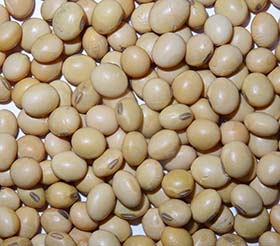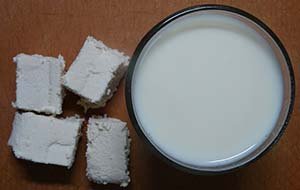Soybean Nutrition facts
The soybean, originating from Northern-East China, is the seed (fruit) of a plant. Apart from its primary use in oil pressing, these beans serve as a significant vegetable protein source globally. They are particularly popular in Asian regions, where processed soybean products like tofu and soy sauce are highly valued.
Soybean belongs to the family of Fabaceae (Leguminosae), in the genus, Glycine.
Scientific name: Glycine max. (L.) Merr.
 |
| Soybeans. |
Soybean, an annual dicotyledonous plant, thrives in porous, adequately moist, and mineral-rich soil. Approximately 70-80 days after planting, the entire soy plant becomes covered with short-stalked green pods. These young soy pods, measuring about 1.5-2 inches long, are swollen, straight, or slightly curved, and contain a single row of 2-5 round, light green, smooth seeds. If left undisturbed, the seeds continue to mature further and dry within the pods.
In the United States, harvesting is primarily conducted using mechanical appliances.
Health Benefits of Soybeans
With 446 calories per 100 g, soybeans contain relatively more calories than some other members of the Fabaceae family.
Its fats are 78% unsaturated, with no cholesterol, and they contain lecithin. Soybeans are beneficial for liver health and are considered balanced yin and yang foods in TCM.
Soybeans provide the highest amount of protein among legumes, with 36.49 g or 65% of the recommended daily value. Its protein is of excellent quality, making soybeans an ideal complement to grain foods.
They contain ample amounts of dietary fiber, vitamins, minerals, and plant sterols.
They contain 9.3 g of dietary fiber per 100 g. Dietary fiber acts as a bulk laxative, protecting the colon mucosa by reducing its exposure time to toxic substances and binding to cancer-causing chemicals in the colon. Additionally, it has been shown to reduce blood cholesterol levels by decreasing the reabsorption of cholesterol-binding bile acids in the colon.
Plant sterols (phytosterols), especially ß-sitosterol, help lower cholesterol levels in the blood.
Soybeans are among the highest sources of folates among legumes. One hundred grams of fresh beans carry 375 µg or 94% of the daily value of folates. Together with vitamin B12, folate is one of the essential components of DNA synthesis and cell division. Consumption of a diet adequate in folates around conception and during pregnancy helps prevent neural tube defects in newborn babies.
Soybeans are among the highest antioxidant sources in the form of isoflavones. The total value of isoflavones in them is 159.54 mg per 100 grams, with daidzein, genistein, and glycetein at levels of 629 mg, 81.35 mg, and 15.29 mg respectively. Isoflavones have been found to reduce post-menopausal cancers and osteoporosis.
Soybeans contain good amounts of phytoestrogen, formononetin, which promotes angiogenesis (the regeneration of new blood vessels).
Soybeans are very good sources of many B-complex vitamins, providing more than 50% of daily values per 100 g for some vitamins such as riboflavin (67%), thiamin (73%), pyridoxine, pantothenic acid, and niacin. Most of these vitamins work as co-enzymes in carbohydrate, protein, and fat metabolism.
Furthermore, they are one of the finest sources of minerals like iron, copper, manganese, phosphorus, zinc, and magnesium. One hundred grams of fresh beans contain 196% of the daily recommended intake (DRI) of iron, 100% of phosphorus, 70% of magnesium, 184% of copper, and 70% of manganese. Manganese is used by the body as a co-factor for the potent antioxidant enzyme, superoxide dismutase.
| Principle | Nutrient Value | Percent of RDA |
|---|---|---|
| Energy | 446 Kcal | 22.3% |
| Carbohydrates | 30.16 g | 23% |
| Protein | 36.49 g | 65% |
| Total Fat | 19.94 g | 99% |
| Cholesterol | 0 mg | 0% |
| Dietary Fiber | 9.3 g | 24% |
| Vitamins | ||
| Folates | 375 µg | 94% |
| Niacin | 1.623 mg | 10% |
| Pantothenic acid | 0.793 mg | 16% |
| Pyridoxine | 0.377 mg | 29% |
| Riboflavin | 0.870 mg | 67% |
| Thiamin | 0.874 mg | 73% |
| Vitamin A | 22 IU | <1% |
| Vitamin C | 6 mg | 10% |
| Vitamin E | 0.85 mg | 6% |
| Vitamin K | 47 µg | 39% |
| Electrolytes | ||
| Sodium | 2 mg | <1% |
| Potassium | 1797 mg | 38% |
| Minerals | ||
| Calcium | 277 mg | 28% |
| Copper | 1.658 µg | 184% |
| Iron | 15.7 mg | 196% |
| Magnesium | 280 mg | 70% |
| Manganese | 2.517 mg | 109% |
| Phosphorus | 704 mg | 100% |
| Zinc | 4.89 mg | 44% |
| Phyto-nutrients | ||
| Carotene-ß | 13 µg | -- |
| Daidzein | 62.90 mg | |
| Genistein | 81.35 mg | |
| Glycetein | 15.29 mg |
Selection and storage
Soybean pods contain seeds of varying colors and hardness. When shopping in markets, opt for dried beans available in packets or bins. Sprouted and toasted soybeans can also be found in these shops throughout the year.
Fresh green soybeans, known as edamame, are commonly found in Japanese and other East Asian markets. In the United States, however, supermarkets typically offer frozen beans in vacuum packs or shelled edamame beans (mukimame).
When storing at home, keep dry beans in an air-sealed plastic or metallic container in a cool, dry area, away from high temperatures and humidity.
For optimal freshness, use young, tender edamame soon after purchase.
Preparation and Serving methods
Before cooking, soybeans necessitate soaking to shorten the cooking duration, retain essential vitamins and minerals, and minimize flatulence.
Dried soybeans typically require at least an hour of cooking time, until they can be easily crushed with a spoon.
Soy granules are soybeans that have been de-husked and milled into granules. Soybean sprouts, akin to mung bean sprouts, are ready to consume after a few days of germination. Soy flour, a gluten-free alternative, boasts 2-3 times more protein content than wheat flour.
Here are some serving tips:
 |
| Soybeans. |
Boiled soybeans and soy chunks added in stews with vegetables and poultry.
Soy milk is a popular health drink.
Soy sauce is made from fermented soybeans. It is used as a condiment in recipes all over the world.
In Japan, specialty restaurants serve tofu (豆腐) recipes like yudofu (スープ豆腐), mabodofu, agedashidofu, etc.
In the US, Soy granules are added to soups, stews, spaghetti sauces, cookies, and bread.
Tempeh is Indonesian fermented soybean cake, served fried with seasonings.
Soybean sprouts are eaten raw or lightly cooked, added in salads, and stews
Soy flour is used in small quantities to bind sauces or to make cakes, muffins, and cookies and as an enriching ingredient.
Safety Profile
Soy beans and their derivatives rank among the most prevalent allergens in food. Individuals with a soybean allergy experience hypersensitivity reactions to soy-containing food items. Symptoms commonly manifest as allergic skin issues such as urticaria, hives, and eczematous dermatitis. In severe instances, symptoms may escalate to vomiting, gastritis, abdominal pain, swelling of the lips and throat resulting in breathing difficulties, wheezing, chest congestion, and, rarely, death. Consequently, individuals with known soy allergies are typically advised to steer clear of any food preparations containing soy.
Fresh soybeans inherently contain anti-nutritional components, which are effectively neutralized through cooking and fermentation. (Medical disclaimer).
You may also like to read ≻≻-
Edamame (Green soybeans) nutrition facts and health benefits.
Sugar Snap Peas nutrition facts and health benefits.
Fava Beans nutrition facts and health benefits.
Lima Beans nutrition facts and health benefits.
≺≺ Back to Legumes from Soybean nutrition. Visit here for an impressive list of legumes with complete illustrations of their nutrition facts and health benefits.
≺≺ Back to Home page.
Further Resources:
Stanford School of Medicine Cancer information Page- Nutrition to Reduce Cancer Risk.